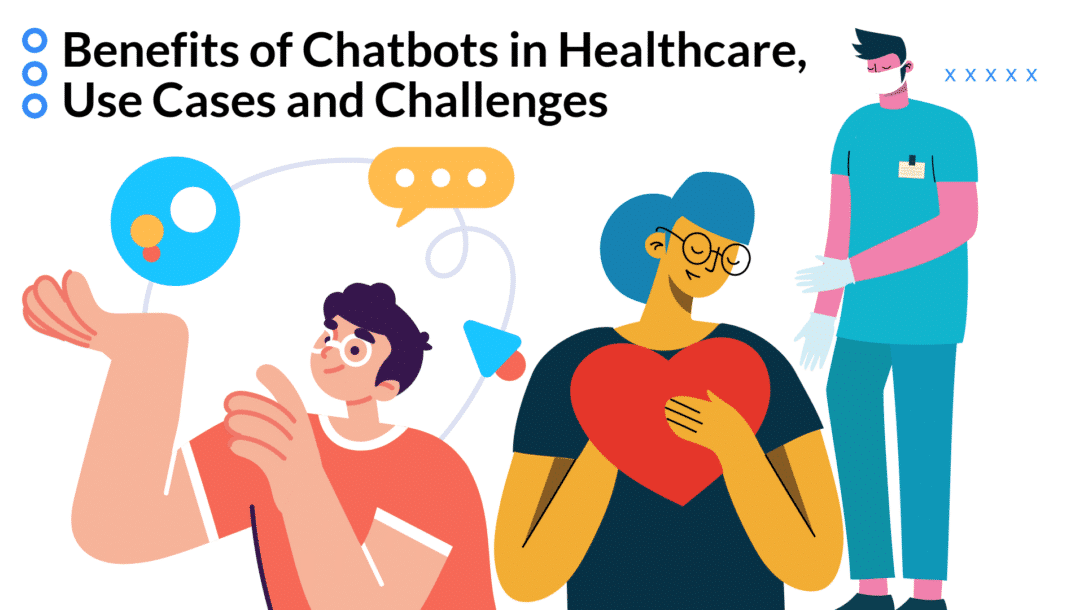It’s a fact that healthcare is becoming increasingly digital. From electronic medical records to telemedicine, technology is transforming how healthcare services are delivered. One of the most exciting advancements in this digital transformation is the use of chatbots in healthcare. The benefits of chatbots in healthcare are vast, and they are quickly becoming an essential tool for the industry.
There is a lot to be gained from using chatbots in healthcare. In this article, we will explore some of the key benefits and how they are revolutionizing healthcare services.
Benefits of chatbots in healthcare: An Overview of Stats and Numbers
As per Zipdo’s report, the worldwide healthcare chatbot market is projected to reach around $498.5 million by 2026.
The latest healthcare statistics indicate that patients seek quick responses to their health concerns at any moment. This factor has made it essential for healthcare providers to embrace chatbots to deliver prompt, round-the-clock services.
In fact, the Accenture Digital Health Consumer Survey predicted that 90% of all patient-physician interactions will involve some type of digital channel in 2024.
Healthcare chatbots — what are they?
Before discussing the benefits of chatbots in healthcare, let’s talk about what they are.
Healthcare chatbots are conversational interfaces that help healthcare providers to interact with patients in a more natural language. They use Artificial Intelligence (AI) and Machine Learning (ML) technologies to mimic human conversation, enabling patients to access health-related information or services seamlessly.
At the heart of healthcare’s digital revolution, chatbots are not just a trend but a game-changer, seamlessly blending artificial intelligence with patient care. Imagine a world where your health concerns are addressed instantly, without the wait time for appointments or the hassle of paperwork.
These chatbots can be integrated into various messaging platforms, such as Facebook Messenger and WhatsApp, and even on healthcare providers’ websites.
Healthcare chatbots are precisely that – intelligent virtual assistants ready to provide medical guidance, answer insurance queries, and facilitate appointment scheduling 24/7.
They’re not just technology; they’re your health companion, making healthcare accessible at your fingertips. Patient engagement, health education, consultation, and more are just some of the services that chatbots offer to enhance patient experience and improve overall healthcare delivery.
Benefits of Chatbots in Healthcare
The core of today’s discussion is the benefits of chatbots in healthcare. Fortunately, there are plenty!
Streamlined Patient Engagement
Chatbots revolutionize patient engagement by offering a seamless, always-on communication channel. Picture a patient easily scheduling appointments, receiving medication reminders, or getting quick health tips—all through a simple conversation with a healthcare chatbot. This 24/7 availability ensures patients receive attention exactly when needed, significantly enhancing the patient experience and boosting satisfaction levels.
Enhanced Accessibility of Information
Imagine the ease with which patients can access medical information without the complexities of navigating through websites or mobile apps. Chatbots in healthcare serve as the ultimate information dispensers, providing instant, accurate responses to patient inquiries about symptoms, treatments, and health conditions. This immediate access empowers patients, making healthcare decisions more informed and reducing unnecessary visits to the doctor.
Efficient Symptom Checking and Preliminary Diagnosis
Automation of Administrative Tasks
Free up valuable human resources by automating routine administrative tasks such as patient intake forms, appointment scheduling, and follow-up surveys through chatbots.
This efficiency reduces the administrative burden on healthcare staff and minimizes human error, leading to a smoother, faster patient service experience. The result? A healthcare system that operates like a well-oiled machine, with staff having more time to focus on critical patient care activities.
Personalized Patient Support and Care
Tailor patient care like never before, with chatbots providing personalized health advice, nutrition plans, and fitness regimes based on individual health records and preferences.
This personalized approach fosters a deeper patient-provider relationship and encourages patients to take an active role in managing their health, leading to improved outcomes and overall well-being. Plus, this custom support is available anytime with chatbots, removing barriers to achieving healthcare goals.
Instant Access to Basic Medical Knowledge
If you’ve ever found yourself googling symptoms and self-diagnosing, you’re not alone. Healthcare chatbots offer a more reliable alternative to Dr. Google, providing instant access to accurate medical knowledge from trusted sources.
This eliminates misinformation and promotes evidence-based healthcare decisions, improving patient outcomes.
Chatbots in healthcare bridge the gap between patients and healthcare providers, offering a new level of patient-centric care. The benefits are clear – improved accessibility, streamlined communication, efficiency gains, and personalized support. With the rising demand for quick and efficient healthcare services, chatbots are here to stay and transform the landscape of healthcare delivery.
You see, the possibilities with chatbots in healthcare are endless. They offer a cost-effective, convenient solution that empowers patients and enhances the efficiency of healthcare delivery. And as technology advances, so will the capabilities of these digital assistants, making them an integral part of the healthcare landscape for years to come.
Types of Chatbots in Healthcare
Now that we’ve explored chatbots’ benefits in healthcare, let’s explore the different types of chatbots used in the industry.
Informative Chatbots
This type of chatbot provides patients with information on healthcare services, insurance coverage, and medical facilities. Informative chatbots are often integrated into a healthcare provider’s website or social media platforms to offer quick and easy access to basic information.
Most patients, particularly younger generations, prefer to communicate through messaging channels. Informative chatbots bridge the gap between traditional websites and modern patient communication preferences, improving overall engagement and satisfaction.
The simplest AI algorithm, rule-based chatbots rely on pre-defined rules and decision trees to guide conversations with patients. These chatbots are best suited for handling simple inquiries and directing patients to the appropriate resources or services.
Conversational Chatbots
With advances in Natural Language Processing (NLP), conversational chatbots can hold more complex, human-like conversations with patients. They use AI algorithms to learn from interactions and improve responses over time, making them ideal for handling more complex patient inquiries.
Conversational chatbots can also integrate with Electronic Health Records (EHR) systems, granting healthcare providers real-time access to patient information during conversations. This integration enhances the accuracy and efficiency of patient care.
Prescriptive Chatbots
This type of chatbot goes beyond providing information and recommendations to prescribing treatments or medications. Prescriptive chatbots use AI algorithms to analyze patient symptoms and medical history, making evidence-based treatment suggestions.
While prescriptive chatbots cannot replace the expertise of a healthcare professional, they can serve as a valuable tool in triaging patients and ensuring timely access to appropriate care. Patients can also use these chatbots for medication reminders and follow-up care instructions, improving adherence to treatment plans.
Chatbot use cases in healthcare
Chatbots are used in various capacities throughout the healthcare industry, from triaging patients to post-discharge follow-up. Here are some examples of how chatbots are transforming healthcare delivery:
Virtual Primary Care
Virtual primary care chatbots provide an alternative for patients seeking basic medical advice and guidance in areas with limited access to physical healthcare facilities. Chatbots, as such, enable patients to receive virtual consultations, schedule appointments, and access basic health information without leaving their homes.
Assess symptoms and triage patients
Prescriptive chatbots can help healthcare providers screen and identify potential health conditions through patient-reported symptoms. This assists in prioritizing care for patients, particularly in busy emergency rooms or during pandemics such as the current COVID-19 crisis.
Post-discharge follow-up
Healthcare providers also use chatbots to track patient recovery after discharge, delivering personalized medication and follow-up appointment reminders. This improves patient adherence to treatment plans and reduces the likelihood of readmissions.
Mental Health Support
Mental health chatbots offer patients access to counseling services and resources anytime, anywhere. These chatbots use Cognitive Behavioral Therapy (CBT) techniques and AI algorithms to provide personalized support, making mental healthcare more accessible and convenient.
Manage Insurance Claims and Billing
Chatbots can also assist patients in managing insurance claims and billing inquiries, simplifying the process and reducing wait times for assistance. This improves patient satisfaction and reduces the administrative burden on healthcare providers.
Managing Chronic Conditions
The most significant advantage of chatbots in healthcare is the ability to provide continuous support and monitoring for patients with chronic conditions. Chatbots can remind patients to take medications, track symptoms, and provide personalized resources for managing their specific conditions.
Medication Refills and Reminders
For patients with chronic conditions or those on long-term medications, chatbots can provide automated medication refill reminders and even place orders for refills directly from the pharmacy. This ensures timely access to medications and reduces the risk of missed doses.
First Aid Assistance
Healthcare chatbots can also provide first aid assistance for minor injuries or illnesses, offering patients step-by-step instructions and resources until they receive proper medical care. This is especially useful in remote areas or during emergencies when immediate access to healthcare may not be available.
Chatbot development for healthcare
Developing a chatbot for healthcare requires collaboration between healthcare professionals, AI developers, and technology experts. The process is challenging as healthcare chatbots must comply with strict privacy and security regulations and accurately reflect medical knowledge and terminology.
Also, healthcare chatbots must be continuously monitored and updated to maintain accuracy and improve patient interactions. As AI technology advances, the potential for chatbot use in healthcare continues to grow, making it a valuable tool for improving patient care and engagement.
It is evident that chatbots will significantly impact healthcare delivery and patient communication in the future.
Following are the steps involved in developing an effective chatbot for healthcare:
Assess your needs:
We shared many healthcare chatbot use cases. Evaluating your specific needs and objectives is essential before beginning the development process. Consider factors such as target audience, language preferences, and integration with existing systems.
Design a conversational flow:
The success of a chatbot depends largely on its ability to engage in natural conversations with users. Designing a conversational flow that reflects real-world interactions is crucial for creating an intuitive and user-friendly chatbot.
Pick the right AI algorithms:
The algorithms employed impact chatbot capabilities and accuracy. For instance, natural language processing (NLP) aids in user query comprehension, while machine learning enhances personalized recommendations.
Integrate with existing systems and databases:
To provide accurate and up-to-date information, it is crucial to integrate the chatbot with existing systems and databases. This will enable the chatbot to access patient records, lab results, and other relevant data.
Test and refine:
Before launch, the team should conduct thorough testing to ensure the chatbot’s accuracy and effectiveness in handling user queries. Continuous monitoring and refinement are essential for enhancing the chatbot’s performance over time.
Clepher offers a user-friendly platform for developing chatbots and automating conversations. With Clepher, healthcare providers can quickly create customized chatbots to assist patients with various tasks and inquiries. Clepher’s chatbot also integrates with popular messaging platforms, making it easy for patients to access their services.
Some other features of Clepher that make it an ideal platform for developing healthcare chatbots include:
- Natural language processing and machine learning capabilities
- Integration with existing systems and databases
- Customizable conversational flow design
- HIPAA compliance for data security and privacy regulations
You need not be a tech expert to develop a chatbot with Clepher. The platform provides comprehensive tutorials and support for AI implementation, making it accessible to healthcare professionals of all levels.
So, start building your healthcare chatbot with Clepher today and enhance patient engagement and care in your practice.
Conclusion: Benefits of chatbots in healthcare
Overall, the use and benefits of chatbots in healthcare have proven beneficial for patients and healthcare providers. With the continuous advancement of AI technology, we can expect to see more sophisticated and versatile healthcare chatbots in the future.
So, it’s time to embrace this technology and leverage its potential to improve the quality of healthcare delivery. Keep exploring new ways to integrate chatbots into your practice and stay at the forefront of patient care. With Clepher, the possibilities are endless!
Related Posts



